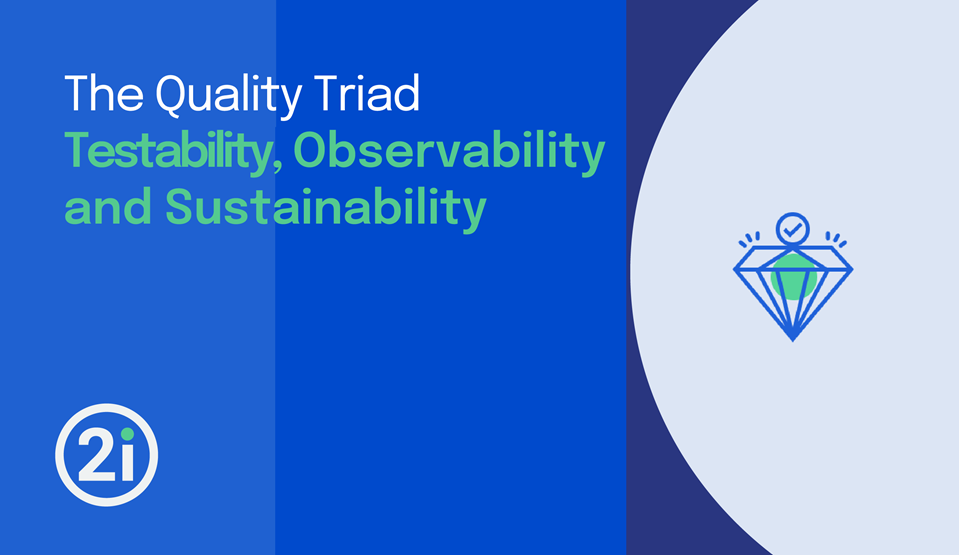In the ever-evolving landscape of software development, ensuring the quality of applications has never been more important, as evidenced in the World Quality Report 2023-24, which stated that quality is now a boardroom priority.
Quality Engineering (QE) teams are constantly seeking innovative approaches to enable organisations to deliver reliable and sustainable software products, driven by a quality-centric mindset. At the heart of a quality-centric mindset are testability, observability, and sustainability - forming what we are calling the "Quality Triad." We highlighted this as key trend to watch in our The Impact of Top 10 Quality Engineering Trends in 2024 blog earlier this year. Let's explore in more detail how these three pillars converge to underpin the foundation of best in class QE practices.
Harnessing the Power of Testability for Software Excellence
Testability refers to the ease with which software can be tested.
A highly testable system is one that allows QE teams to design, implement, and execute tests efficiently and effectively. Testability is not just about having a comprehensive suite of test cases but also about the architecture and design choices that facilitate testing. By incorporating principles such as modularity, encapsulation, and dependency injection, developers can create code that is inherently easier to test.
Testability goes beyond how we design and build software to be easier to test. Focusing on Testability as a quality characteristics helps us ask the right questions when we are elaborating ideas and designing software.
Why would this feature be important to a user or the business?
How would the user interact with this software?
What is the value that we are trying to achieve?
Asking questions of this nature at this early stage ensures we design software with a common understanding of the goal and what is important. This is key to shaping effective acceptance criteria, identifying product quality risks, and crucially the why, what and how we will test the software.
Testability is vital in the prevention of issues being injected into software delivery and early identification of issues, thus reducing the cost and effort associated with fixes and rework.
Ultimately, prioritising testability leads to higher-quality software that meets user expectations and withstands the rigours of real-world usage.
The Impact of Observability in Software Development
Observability refers to the ability to understand and diagnose the internal state of a system based on its external outputs.
Observability encompasses various practices, including logging, monitoring, and tracing, which provide visibility into system performance, errors, and user interactions. In essence, it enables QE teams to gain insights into how software behaves in different scenarios, allowing them to learn and adapt their testing to better reflect how production systems behave and users interact with the software.
By investing in robust observability tools and frameworks, organisations can proactively monitor their applications, identify potential bottlenecks or failures, and take timely corrective actions. This proactive approach is powerful in supporting and managing production services. Often these tools are only made available to production support teams, which is missing an opportunity. Introducing these tools as part of software delivery not only enhances the reliability and resilience of software systems but also fosters a culture of continuous improvement and innovation.
The impact of observability in software delivery is enabling businesses to deliver exceptional user experiences in an increasingly digital world.
Driving Innovation Through Sustainable Software Practices
Sustainability extends beyond traditional notions of software quality to encompass broader environmental, social, and economic considerations.
A sustainable software product is one that minimises its environmental footprint, promotes social equity, and ensures long-term economic viability. Sustainable QE practices involve assessing the environmental impact of software operations, promoting accessibility and inclusivity, and optimising resource utilisation.
By integrating sustainability into software delivery, organisations can reduce energy consumption, mitigate carbon emissions, and promote responsible use of technology. Moreover, sustainable software enhances user satisfaction by catering to diverse user needs and upholding ethical principles. From an economic standpoint, sustainable software minimises maintenance costs, fosters innovation, and contributes to long-term business success.
The World Quality Report 2023-24 states that “64% of respondents recognise quality ecosystem sustainability as a priority, not just for themselves but for customers and investors as well, with the economic, social, and environmental benefits being profound.”. We believe this is going to become an increasing priority, as society considers their impact on the environment with greater regulation and legislation being introduced, businesses and customers are increasingly cost conscious, and software must meet the needs of diverse user groups and avoid digital exclusion.
Join the conversation with us on LinkedIn or Twitter

